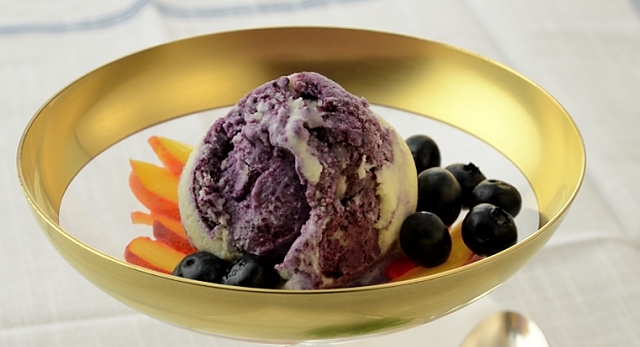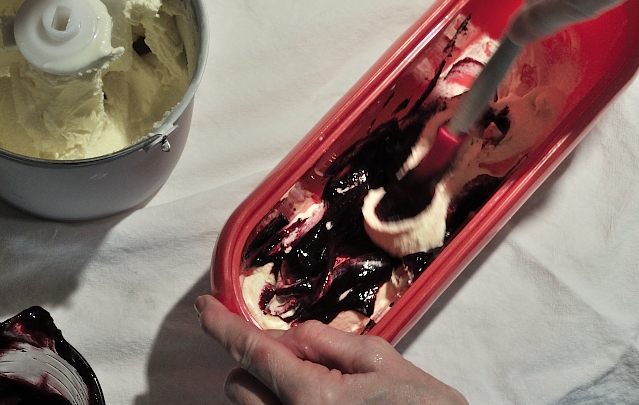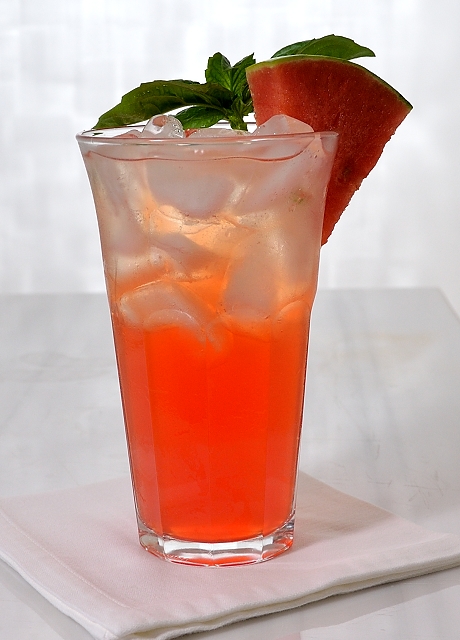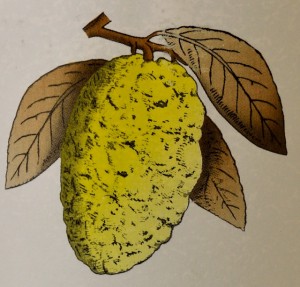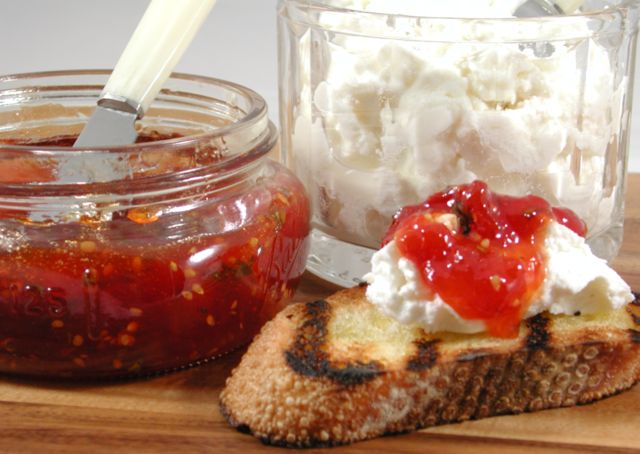Topic Index
The font size for a topic word is sized by the number of articles that reference that topic. The more articles the bigger the font.
Click on a word to search for posts with that topic. This page will reload with the search results.
Basil Blueberry Swirl Gelato
I have never been tempted by desserts with savory components. Somehow they always seemed wrong to me, so when I developed a craving for basil gelato I was surprised. Maybe it started with gorgeous peaches. Bart brought home a dozen of the most fragrant and perfectly ripe pieces of fruit I have seen all summer. My first thought was to slice the peaches, toss them in basil simple syrup and keep life easy. Then I remembered the blueberries in the refrigerator. Next, my eye drifted to my ice cream maker, and I was all in for this one.
The basil gelato base is lightly flavored, a lovely match for the blueberry swirl. Use more basil if you must, up to 50% more, but be careful, tasting occasionally after 15 minutes to be certain the infusion does not take on a bitter edge. I was concerned that the blueberry swirl might not have the body, taste-wise, to stand up to the basil, so I added some Mandorla grappa. The bitter almond and dark cherry taste of the grappa did the trick, brightening the blueberry flavor and bringing it into tight focus. This gelato is wonderful by itself, right out of the container, but served with fresh or poached yellow peaches or nectarines, or even berries, it is a very special summertime treat indeed.
Basil-Blueberry Swirl Gelato
Makes about 1 quart
After a few hours in the freezer, this takes on the perfect consistency, but after a longer freeze will be quite firm. If you find the gelato too firm to scoop, just leave it at room temperature for a few minutes. It will soften beautifully.
2 cups whole milk
¾ cup heavy cream
½ cup granulated sugar
4 large egg yolks
20 basil leaves, coarsely chopped
Pinch of kosher salt
1 ¼ cup blueberries
1 tablespoon granulated sugar
1 tablespoon fresh lemon juice
1-2 teaspoons Nardini Mandorla Grappa
Peaches, nectarines or fresh berries to serve alongside
basil leaves for garnish
Make the basil gelato:
In a medium saucepan combine milk, cream, granulated sugar, basil, and kosher salt. Cook over medium heat, stirring occasionally until the sugar has dissolved. Continue cooking until small bubbles form around the edges of the pan. Remove from the heat, cover pan and set aside to steep for twenty minutes. Strain the mixture, and return it to the pan, reheating briefly. Discard the basil.
While the mixture is heating, separate the eggs, placing the yolks in a medium heat-proof bowl, reserving the whites for another use. Whisk the egg yolks until slightly lightened. Slowly dribble half of the hot milk mixture into the beaten yolks, whisking all the while. Return the mixture to the saucepan and cook over medium heat. Use a silicone spatula to stir and scrape the bottom and sides of the saucepan until the mixture coats the back of the spatula, or reaches 180 degrees F. Do not boil.
Place a strainer over a medium stainless steel bowl and pour the mixture through. Set the bowl containing the gelato base over a second, larger bowl half-full of ice water to cool. Stir occasionally, being careful that no water seeps into the gelato base, until the mixture is cool. Cover and refrigerate 6 hours or overnight to chill thoroughly.
Make the Blueberry Swirl:
Place the blueberries, granulated sugar and lemon juice in a small saucepan and cook over medium-low to medium heat, crushing the berries as they soften and stirring often to prevent sticking and scorching. Cook until a silicone spatula leaves a broad trail when drawn across the bottom of the pan and mixture forms a thick sauce, about 12 to 15 minutes. Place a fine mesh strainer over a bowl. Use a spatula to press the mixture through the strainer, leaving the seeds and skins behind. Use a clean spatula to scrape the mixture that clings to the underside of the strainer into the bowl. This should yield about ¼ cup of puree. Discard seeds and skins. Add grappa to the puree, and stir to combine. Refrigerate until cold.
Make the gelato:
Pour the chilled base mixture into an ice cream/gelato maker and process according to the manufacturer’s directions.
Add the swirl:
When gelato has finished churning, Remove the cannister from the machine and transfer one half of the gelato to a chilled storage container, smoothing the top slightly. Pour one half of the blueberry mixture atop gelato and swirl or fold gently using just a few strokes, lifting and swirling the blueberry mixture. Repeat with the remaining ingredients. Stir as little as possible to retain rivulets of blueberry. Smooth the surface of the gelato. Place a piece of plastic wrap directly atop the gelato, and transfer to the freezer 4 to 6 hours to harden and cure.
Food Nerd Notes: To those of you who are wondering, yes, I finally got my fancy ice cream maker. I love it. Come on over.
Further reading:
Gelato!: Italian Ice Creams, Sorbetti, and Granite
by Pamela Sheldon Johns
Paperback: 112 pages
Publisher: Ten Speed Press (May 1, 2008)
Language: English
ISBN-10: 1580089232
ISBN-13: 978-1580089234
The Perfect Scoop: Ice Creams, Sorbets, Granitas, and Sweet Accompaniments
by David Lebovitz
Paperback: 256 pages
Publisher: Ten Speed Press (May 4, 2010)
Language: English
ISBN-10: 158008219X
ISBN-13: 978-158008219
The Ciao Bella Book of Gelato and Sorbetto: Bold, Fresh Flavors to Make at Home
Publisher: Clarkson Potter (May 11, 2010)
Hardcover: 176 pages
Language: English
ISBN-10: 0307464989
ISBN-13: 978-0307464989
Sweet Cream and Sugar Cones:
90 Recipes for Making Your Own Ice Cream and Frozen Treats from Bi-Rite Creamery
Hardcover: 224 pages
Publisher: Ten Speed Press (April 17, 2012)
Language: English
ISBN-10: 1607741849
ISBN-13: 978-1607741848
Making Artisan Gelato:
45 Recipes and Techniques for Crafting Flavor-Infused Gelato and Sorbet at Home
Paperback: 176 pages
Publisher: Quarry Books (January 1, 2009)
Language: English
ISBN-10: 159253418X
ISBN-13: 978-1592534180
A Passion for Ice Cream:
95 Recipes for Fabulous Desserts
by Emily Luchetti
Hardcover: 224 pages
Publisher: Chronicle Books; First Edition (April 27, 2006)
Language: English
ISBN-10: 0811846024
ISBN-13: 978-0811846028
Note: You can click on any picture to see a slide show!
I have no affiliation with any product, manufacturer, or site mentioned in this article.
Cicerchie and Black Kale Soup
What beans! What character! The humble cicerchie, Lathyrus sativus, with their hearty flavor have been a character on the world food scene for thousands of years. Paleobotanists have determined that cicerchie came to ancient Rome from Greece, having first made their way from the Near East along the northern coast of the Mediterranean. The ancient Romans called the legume cicercula, and the march of the Roman legions was fueled on soup made from them. Because cicerchie grow well in high altitudes and cool climates they have traditionally played a large part in the cuisine and farming of the central and southern Apennines, especially Abruzzo where they sustained the poor through good times and bad. Cicerchie farming and consumption decreased after WW II, but a resurgence is underway, thanks to the burgeoning interest in traditional foods and sustainable agriculture both in Italy and worldwide.
However, cicerchie have one characteristic that sets them apart and is worth addressing. They contain the neurotoxic amino acid Read the remainder of this entry »
La Rosalia – A Happy Marriage of Watermelon, Aperol and Basil
Call it a cooler. Call it refreshing. And call our weather hot, hot, hot. For the last few days I have been looking for cool, but not too sweet drinks, and I came up with this one. In our house watermelon defines summertime, and since it’s still watermelon season, I thought I would use it in a beverage. Read the remainder of this entry »
Acqua di Cedro – a Drink and a Panna Cotta
 Move over Limoncello. Acqua di Cedro has arrived. This clear liqueur is made with citron, cedro in Italian (botanical name – Citrus medica.) Poor unattractive and underused citron, aside from its candied peel used for Christmas baking, it is pretty much ignored in my kitchen. Not so however on my dressing table where its essential oils form the base of many of my favorite perfumes. This most ancient of citrus with its gnarled and bumpy skin is said to have flourished in the Hanging Gardens of Babylon and was brought to Italy by Alexander the Great – this baby’s got some history behind it. Read the remainder of this entry »
Move over Limoncello. Acqua di Cedro has arrived. This clear liqueur is made with citron, cedro in Italian (botanical name – Citrus medica.) Poor unattractive and underused citron, aside from its candied peel used for Christmas baking, it is pretty much ignored in my kitchen. Not so however on my dressing table where its essential oils form the base of many of my favorite perfumes. This most ancient of citrus with its gnarled and bumpy skin is said to have flourished in the Hanging Gardens of Babylon and was brought to Italy by Alexander the Great – this baby’s got some history behind it. Read the remainder of this entry »
Corzetti: The Intagliatore of Chiavari

This is Part 2 of a series – The Corzetti Files
For detailed information and photo essays on how to make corzetti, along with recipes, please delve further into The Corzetti Files:
Edible Art, The Corzetti Files – Part 1
The Intagliatore of Chiavari, The Corzetti Files – Part 2
Corzetti agli Spinaci con Gorgonzola, The Corzetti Files – Part 3
Where to Buy Corzetti Stamps, The Corzetti Files – Part 4
Corzetti Stampati – and a Giveaway! The Corzetti Files – Part 5
A Gold Coin
 The pasta we know as Corzetti started with a gold coin, the Genovino d’oro. Rome had fallen, and the curtain of The Dark Ages had descended over western Europe. Trade has fueled society for centuries, and it is trade that brought gold coins and light back to western Europe. The gold came across the Sahara from north Africa and Genoa’s harbor assured her of preeminent mercantile stature. King Conrad granted Genoa the right to mint her own gold coinage in 1252, and these pieces of almost pure gold summon up the history and wealth of The Most Serene Republic of Genoa.
The pasta we know as Corzetti started with a gold coin, the Genovino d’oro. Rome had fallen, and the curtain of The Dark Ages had descended over western Europe. Trade has fueled society for centuries, and it is trade that brought gold coins and light back to western Europe. The gold came across the Sahara from north Africa and Genoa’s harbor assured her of preeminent mercantile stature. King Conrad granted Genoa the right to mint her own gold coinage in 1252, and these pieces of almost pure gold summon up the history and wealth of The Most Serene Republic of Genoa.
 Coming in at about 3.5 grams, the earliest of these coins feature the city gate and to honor King Conrad and his participation in the Crusades, a Crusader cross on the reverse. The coins are covered with a beautiful relief. One of the most famous coins honors the first Doge of Genoa, Simone Boccanegra, and later coins honor subsequent families and Doges. Today one must visit a museum or be fortunate enough to know a collector to view these coins, but with Liguria’s gift to the world of the pasta known as corzetti stampati (kohr-TSEHT-tee stahm-PAH-tee), the legacy of these glorious coins is alive and well and available to us all.
Coming in at about 3.5 grams, the earliest of these coins feature the city gate and to honor King Conrad and his participation in the Crusades, a Crusader cross on the reverse. The coins are covered with a beautiful relief. One of the most famous coins honors the first Doge of Genoa, Simone Boccanegra, and later coins honor subsequent families and Doges. Today one must visit a museum or be fortunate enough to know a collector to view these coins, but with Liguria’s gift to the world of the pasta known as corzetti stampati (kohr-TSEHT-tee stahm-PAH-tee), the legacy of these glorious coins is alive and well and available to us all.
A Piece of Wood
I have an ongoing love affair with handmade pasta, and this one captivated me from the start. Imagine my delight when I discovered its history, how it was made, and that I could do it at home. All I needed was a corzetti stamp, the two piece tool that cuts and imprints the pasta. By the way, you may come across pasta in shops, in recipes or on menus called croxetti, crosetti or curzetti – these are all names for corzetti. Read the remainder of this entry »
Tomato Jam
Well, I walked out into my garden yesterday morning and I started picking Juliet tomatoes. And I picked. And I picked. By the time I finished I was astounded at the morning’s yield from one plant. And in just a couple of minutes. Astounded, I say. There were four and one-half pounds! First off I reflected on how pleased I was with the yield from my one very productive Juliet plant. Then I got practical. I thought about what I was going to do with them. Ovoid, red, firm and juicy, they are one of my favorite tomatoes. I could eat them out of hand. I could make my favorite eggs for breakfast, Cheesy Eggs, that is. See my older post on the subject. I could share them with neighbors. Or I could do what any cook does in August when faced with abbondanza such as this. Make jam. Yes, indeed. Tomato jam. If you have never had it, stay with me. Tomato jam is sweet, the very essence of tomato. Over the years I have seen many recipes. Some call for nothing more than tomatoes and sugar. Others call for the addition of citrus juice and or zest, red wine vinegar, cinnamon, cumin, chiles de arbol, jalapenos, cloves, ginger, bay leaves, and that is just for starters. Remembering a post about Sicilian Tomato Jam from Judy of Divina Cucina and another from Deborah of Italian Food Forever, I got to work. One thing I love about cooking is looking at another’s work and building upon it. So here with sincere thanks to both Judy and Deborah is my version of Tomato Jam.
